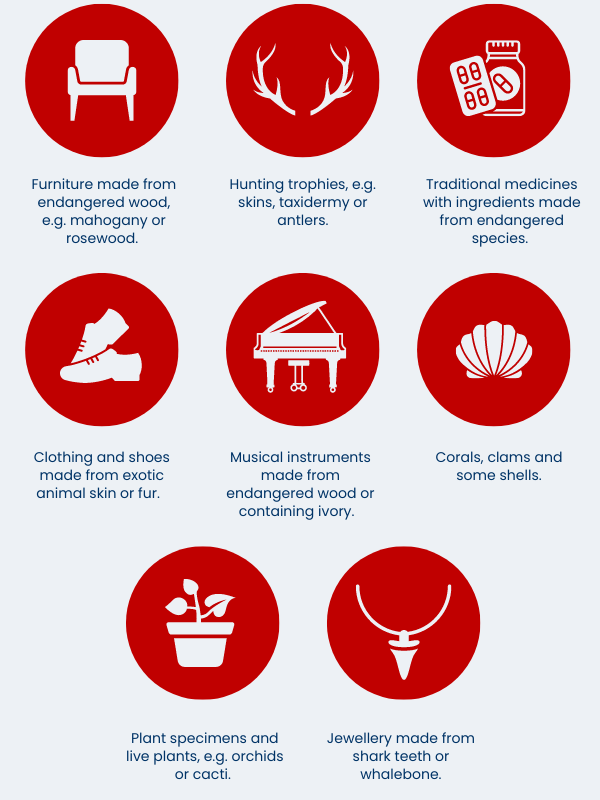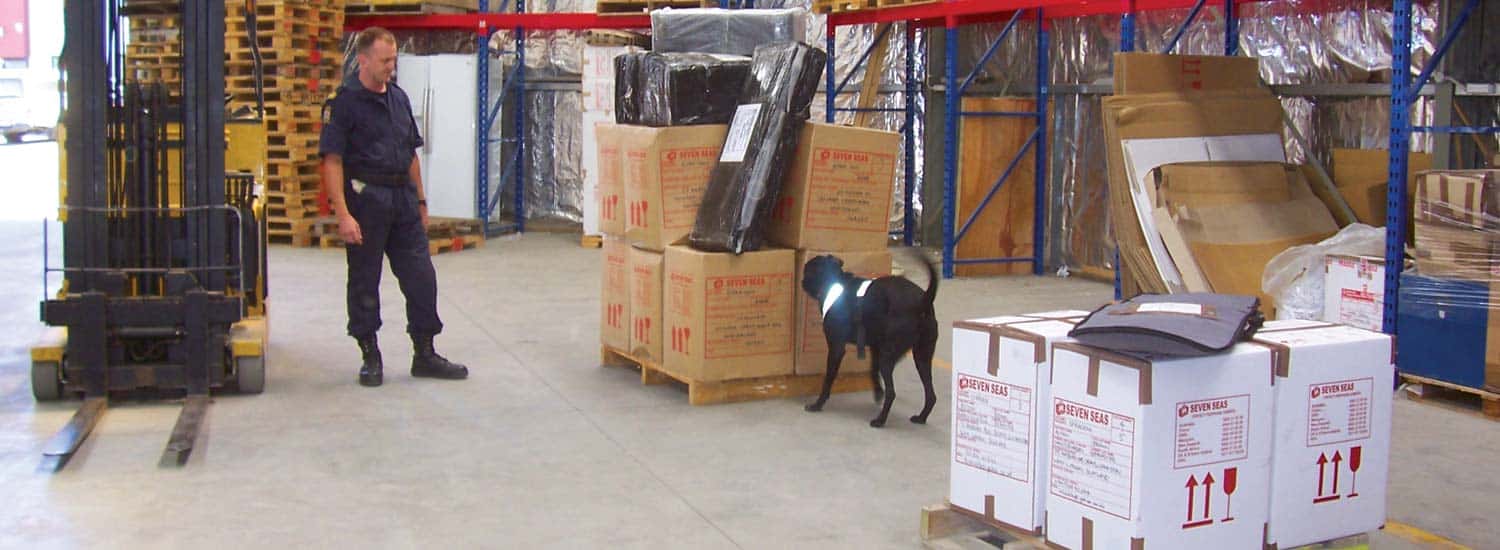Before packing, check this list of items prohibited from entering a particular country or region.
Key takeaways
- A CITES permit is a document authorising the international trade of specific wood, plants and animals listed under the Convention on International Trade in Endangered Species of Wild Fauna and Flora (CITES).
- CITES is an international agreement between 184 governments worldwide to ensure that international trade in wild animals, wood, and plants does not threaten their survival.
- To obtain a CITES permit, you must apply through your country's designated CITES Management Authority.
What is a CITES permit?
A CITES permit is a document authorising the international trade of specific wood, plants and animals listed under the Convention on International Trade in Endangered Species of Wild Fauna and Flora (CITES). Obtaining a permit plays a crucial role in maintaining worldwide biodiversity by regulating and monitoring the trade of endangered species, ensuring it's sustainable and legal.
Depending on the species and the type of trade, you'll need either an export, import or re-export permit. Obtaining a CITES permit involves rigorous checks and compliance with international and national regulations. Permits are issued by the designated CITES Management Authority in each participating country, following the guidelines set by the convention.
CITES protection applies to endangered animals and plants in any form...
What is CITES?
CITES is an international agreement between 184 governments worldwide to ensure that international trade in wild animals, wood, and plants does not threaten their survival. Established in 1975, CITES provides a legal framework for preventing the overexploitation of endangered species via illegal trade. Each member country works together to regulate and monitor the trade of thousands of species.
All import, export, re-export and introduction of species covered by CITES is authorised through a licensing system. Each party designates one or more Management Authorities to administer the licensing system and one or more Scientific Authorities to advise them on the effects of trade on the species status.
What is the difference between CITES Appendix I, II and III?
CITES lists species in three appendices based on the degree of protection required:
- Appendix I: species threatened with immediate extinction. Trade in such specimens is subject to stringent regulation to protect their survival.
- Appendix II: species not threatened with immediate extinction, but extinction is possible without proper conservation and protection.
- Appendix III: species protected in at least one CITES member country who have requested the cooperation of other CITES parties in controlling trade.
Do I need a CITES permit?
You may need a CITES permit if you're involved in the international trade of any animal or plant species included in the CITES appendices. CITES permits cover activities such as exporting, importing, re-exporting or introducing specimens from the sea. Whether you're buying a pet or plant, a commercial trader or a scientific institution, requirements depend on the exact species and the nature of the trade.
Check your country's CITES Management Authority to determine your required permit and fully understand the application process.

Items that need a CITES permit for overseas shipping:
CITES protection applies to endangered animals and plants in any form, whether alive or dead, whole or in parts, or any products made from them.
Below are a few common items you might want to ship overseas and not realise require a CITES permit to import and export, including furniture made from endangered wood, pianos with ivory keys, hunting trophies, traditional medicines and clothing or shoes made from exotic leather or fur.


What does CITES do?
CITES protects endangered species by issuing permits and certificates regulating the listed species' worldwide trade. By carefully categorising over forty thousand species, CITES's work ensures the continued protection of vulnerable plants, animals and wood.
The permit system involves thorough scientific and legal review processes to assess the impact of trade on species populations. This global framework helps coordinate conservation efforts, promotes sustainable trade practices and combats illegal wildlife trafficking.
The World Wide Fund for Nature (WWF) calls CITES "one of the cornerstones of international conservation," which "brings together law enforcement officers from wildlife authorities, national parks, customs, and police agencies to collaborate on efforts to combat wildlife crime".
For example, the trade of ivory has significantly reduced due to strict regulations and international cooperation facilitated by CITES.
What does CITES stand for?
CITES stands for the Convention on International Trade in Endangered Species of Wild Fauna and Flora. It is an international treaty designed to ensure that global trade does not threaten the survival of wild animal, wood and plant species.
Each participating CITES member sets fees based on administration processes, the species involved and the kind of trade.
How to obtain a CITES permit
To obtain a CITES permit, you must apply through your country's designated CITES Management Authority.
Here are some worldwide CITES Management Authorities:
- Argentina: ambiente.gov.ar
- Australia: dcceew.gov.au/environment/wildlife-trade/cites
- Brazil: cites.org/eng/parties/country-profiles/br
- Canada: canada.ca/en/environment-climate-change/services/convention-international-trade-endangered-species.html
- China: cites.org/eng/parties/country-profiles/cn
- Egypt: cites.org/eng/parties/country-profiles/eg
- France: cites.application.developpement-durable.gouv.fr/accueilInternaute.do
- Germany: cites.org/eng/parties/country-profiles/de
- Iceland: cites.org/eng/parties/country-profiles/is
- Japan: cites.org/eng/parties/country-profiles/jp
- Mexico: cites.org/eng/parties/country-profiles/mx
- New Zealand: doc.govt.nz/cites
- South Africa: cites.org/eng/parties/country-profiles/za
- United Kingdom: gov.uk/guidance/cites-imports-and-exports
- United States: fws.gov/international/cites/
The CITES permit application explained
The CITES permit application starts with you identifying the species you want to trade and checking if it is listed under one of the CITES appendices.
Next, complete the application form, providing accurate information about the specimen, its origin, and the trade. You may need documentation, such as proof of legal purchase or scientific data, to support its sustainability.
Then, submit your application, applicable fees, and documents to your country's CITES Management Authority, who will review your submission.
Finally, if approved, you'll receive the permit, which must accompany the specimen during the trade.

How much does a CITES permit cost?
A CITES permit cost varies by country and the type of permit required. Each participating CITES member sets fees based on administration processes, the species involved and the kind of trade.
In some nations, permits for Appendix I species, which require more stringent checks and documentation, may be more expensive than those for Appendix II or III species. Additional costs could include inspection, legal documentation and consultation fees with the Scientific Authority.
It's essential to check with your national CITES Management Authority for precise information on permit fees and any other associated costs.
Here are some prices for animal and plant species CITES permits as of 2024 in select countries:
Canada
All permits are free of charge.
Germany
All permits: from $17-65
Iceland
All permits: $175
New Zealand
All permits: $50
The United Kingdom
Animal permits:
Import permit: $85
Export permit: $80
Re-export permit: $47
Plant permits:
Import permit: $94
Export permit: $94
Re-export permit: $75

CITES permit requirements
CITES permit requirements vary depending on the species of animals or plants and the type of trade you wish to make. Generally, you must provide detailed information, including the species' scientific name, origin, and a full description.
The following are specific requirements depending on the species CITES Appendix:
- Appendix I species: you must demonstrate that the purchase was not violating national laws and that the trade will not threaten the species' survival. You'll need an export permit from the country of origin and an import permit from your destination country.
- Appendix II species: you must show that the trade is sustainable and will not harm the species' survival. You'll typically only need an export permit.
- Appendix III species: you'll need an export permit or certificate of origin from the seller. Additional requirements may include proof of acquisition, purpose of the trade and compliance with animal welfare standards.











